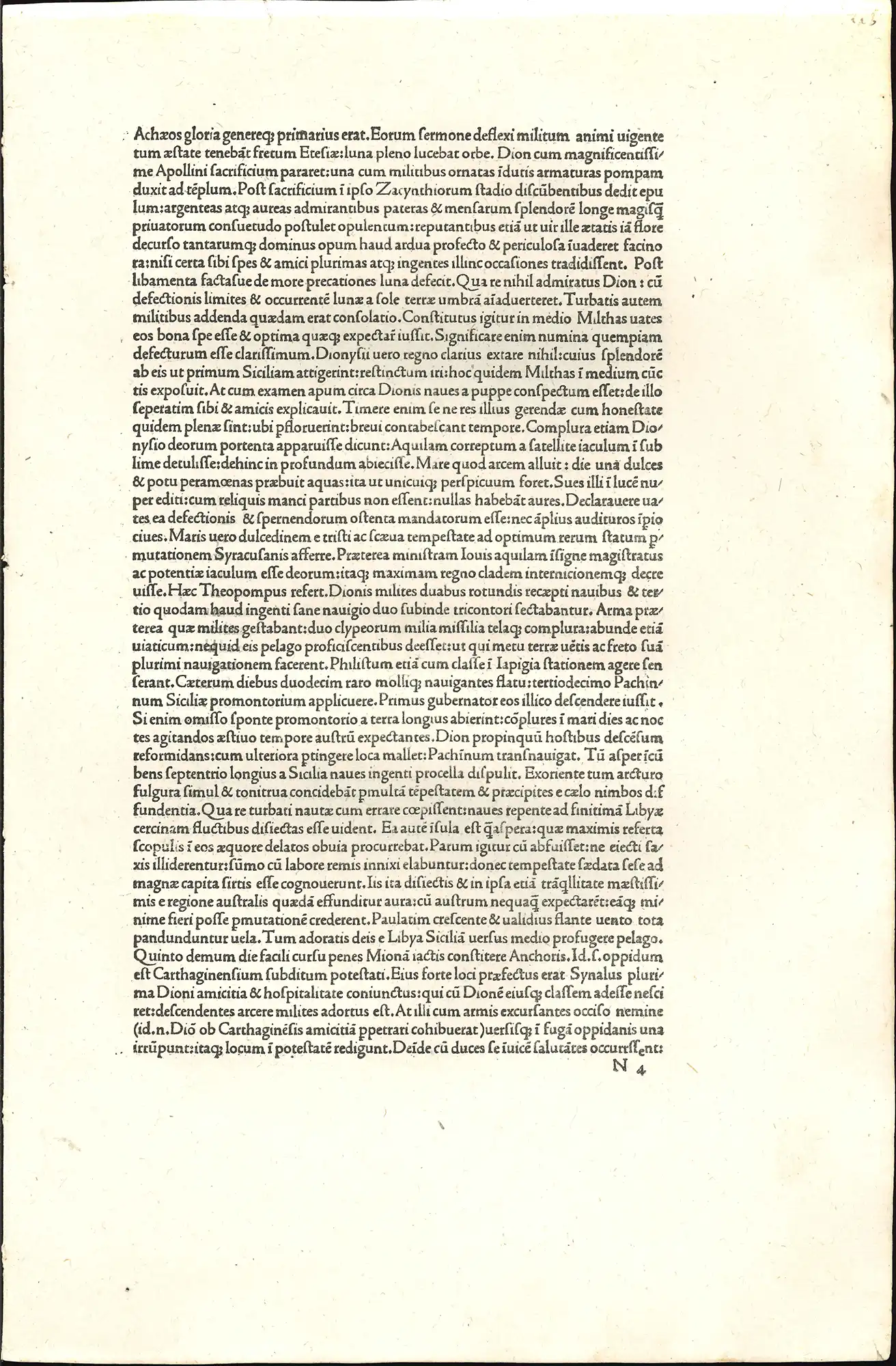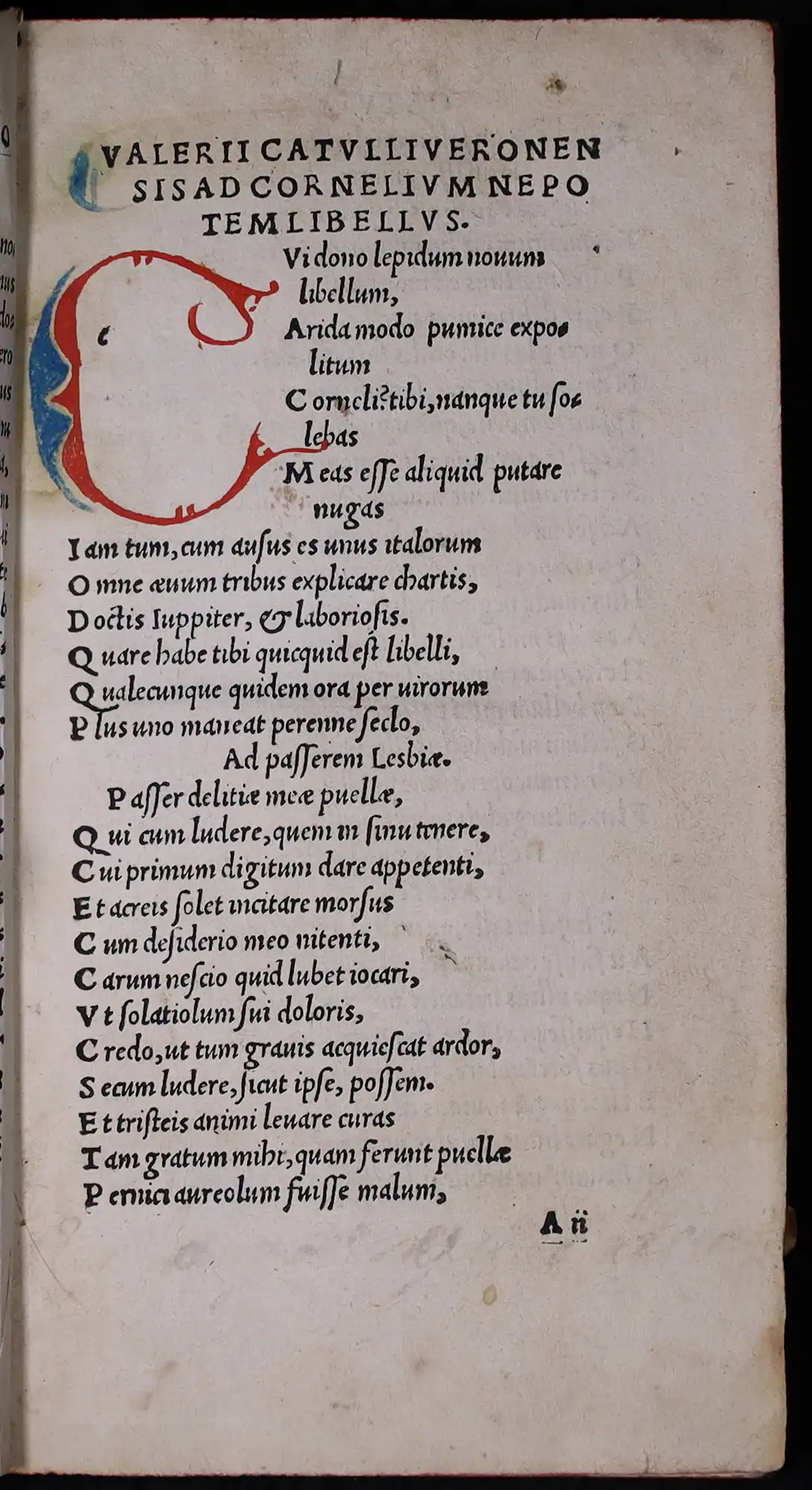Case 10
- Venice: Jenson and Manutius

Plutarch. Vitae parallelae. Venice: Nicolaus Jenson, 1478. Bifolia.
Nicolaus Jenson (ca. 1435–80) was a pioneering printer, engraver, and typographer. He is thought to have been sent to Mainz by Charles VIII in 1458 to learn the art of printing and bring this knowledge back to France. Jenson’s printing career began in 1470 when he became the second printer in Venice after the brothers de Speyer.
It was in Venice that Jenson cut his famed roman typeface. The font was revolutionary for being deliberately based on typographical and aesthetic principles rather than manuscript hands, as had previous typefaces. This font was first employed in his 1470 edition of Eusebius’s De evangelica praeparatione. Jenson went on to cut a Greek type used for quotations the following year and a gothic typeface for medical and history books in 1473.
The displayed bifolia is from the Parallel Lives of Greek historian and biographer Plutarch (ca. 46–120 A.D.) It is a collection of biographies on forty-six famous Greek and Roman philosophers and politicians. The text is from the Life of Dion (a 4th century B.C. ruler of Syracuse in Sicily).

Catullus. Tibullus. Propertius. Venice: Aldus Manutius, 1502.
Aldus Manutius (ca.1450–1515) is one of the most famous of the early Venetian printers and the first great scholar-printer. The founder of the Aldine Press, he is known for producing accurate texts, exquisite printing, and his efforts to restore Greek classical learning. The name of Aldus is most associated with the dolphin and anchor printer’s device, and for producing small octavo-sized books printed in italic type after 1500. His Hypnerotomachia Poliphili (1499) is one of the most typographically superb books of the fifteenth century.
The Reed Collection includes a 1502 octavo edition of the works of three Latin poets. This book is characteristically Aldine in its small, portable format, printed in condensed, narrow, italic script, and published without commentary at relatively low cost.
![Marcus Tullius Cicero. M. Tullii Ciceronis orationum uolumen primum, in quo multa, quae in aliarum editionem libris corrupte legebantur, ex diligenti uetustorum exemplariu[m] collatione sunt emendata. Venice: Paulus Manutius, 1540.](https://www.reedgallery.co.nz/__data/assets/image/0005/999680/10c.webp)
Marcus Tullius Cicero. M. Tullii Ciceronis orationum uolumen primum, in quo multa, quae in aliarum editionem libris corrupte legebantur, ex diligenti uetustorum exemplariu[m] collatione sunt emendata. Venice: Paulus Manutius, 1540.
The firm of Manutius maintained its honoured place for more than a century. After Aldus’s death in 1515, his father-in-law acted as faithful steward for Aldus’s third son Paulus Manutius (1512-74), until the latter came to maturity. More a scholar than a man of business, Paulus increased the fame of the firm through his excellent editions, notably of Cicero, but failed to maintain the commercial success of Aldus. The firm continued for a third generation through Paulus’s son Aldus the younger until 1590.
The Reed Collection includes a copy of Paulus’s 1540 edition of Cicero’s speeches, which has the famous printer's device of Manutius on the title page and final page.
![Marcus Tullius Cicero. M. Tullii Ciceronis orationum uolumen primum, in quo multa, quae in aliarum editionem libris corrupte legebantur, ex diligenti uetustorum exemplariu[m] collatione sunt emendata. Venice: Paulus Manutius, 1540.](https://www.reedgallery.co.nz/__data/assets/image/0005/999680/10c.webp)
Marcus Tullius Cicero. M. Tullii Ciceronis orationum uolumen primum, in quo multa, quae in aliarum editionem libris corrupte legebantur, ex diligenti uetustorum exemplariu[m] collatione sunt emendata. Venice: Paulus Manutius, 1540.
Open image in new window


![Marcus Tullius Cicero. M. Tullii Ciceronis orationum uolumen primum, in quo multa, quae in aliarum editionem libris corrupte legebantur, ex diligenti uetustorum exemplariu[m] collatione sunt emendata. Venice: Paulus Manutius, 1540.](https://www.reedgallery.co.nz/__data/assets/image/0005/999680/10c.webp)